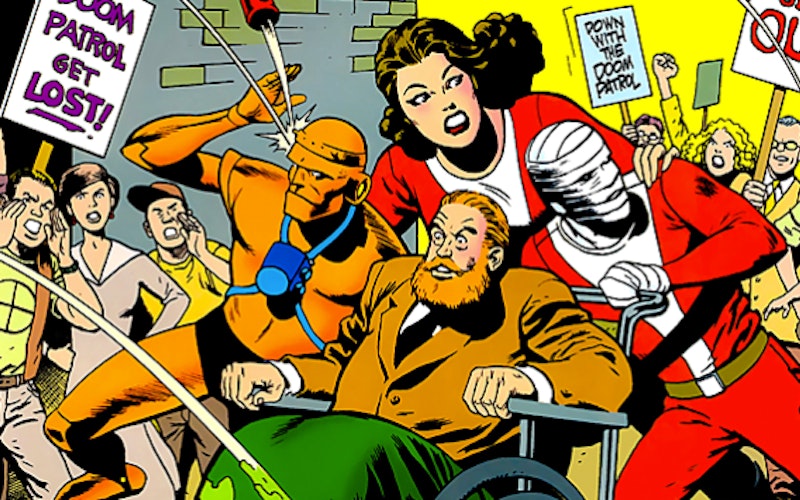
Culture At Large
Doom Patrol's Gospel of Strangeness
Two people stand outside in a downpour. One, a woman named Crazy Jane, asks, “What do normal people have?” The other, former race car driver Cliff Steele, whose brain was removed after a horrible crash and placed inside a hulking bronze robot, responds with the obvious: “You’re asking the wrong person.” Cliff listens as Jane breaks down and sobs about her inability to be normal or strong. And then, after pausing a moment, he takes her arm and says, “Come in out of the rain.”
This conversation comes from 1989’s Doom Patrol #19, and it represents a common character interaction for this series. Debuting in 1963 with the tagline “The World’s Strangest Heroes,” the Doom Patrol has always been DC Comics’ team of oddballs: rejected by society after freak accidents gave them bizarre powers, they find meaning by joining with other misfits. It’s a situation that’s not unfamiliar to many of us who are part of the uniquely aware misfits known as the Body of Christ.
The Doom Patrol’s roster has included everyone from the aforementioned Robotman, Cliff Steele, to a four-armed ape-man to a sentient city block named Danny the Street, but no character better embodies the Doom Patrol’s ethos, and its acceptance of outsiders, than Kay Challis, aka Crazy Jane.
Crazy Jane has been largely defined by brokenness. She has multiple personality disorder, and each of her 64 personalities have different superpowers. These personalities stem from a consciousness that fractured when the then 5-year-old Kay’s father sexually abused her. She’s often depicted next to random puzzle pieces or within a subway system in her mind—each stop representing a different identity—images that suggest a state of permanent disrepair.
Reimagined by series writer Gerard Way, Crazy Jane rejoins the team in last year’s Doom Patrol #6, in which her teammates find her controlled by a 65th personality called Doctor Harrison. A grotesque amalgam of the psychiatrists who’ve treated Kay, Harrison plans to cure herself by killing off the other 64 personalities.
Riding in Jane’s mental subway station (comic book logic; don’t ask), Cliff wonders, “Isn’t being cured a positive thing?” Jane responds by affirming the importance of community, declaring “Healing is a collaborative act, not a relationship of control.” Explaining that she’s come to accept herself, even in her oddness, she asks for Cliff’s support by telling him, “I’d love for you to do the same.”
Penciller Nick Derington places Jane and Cliff on opposite sides of the panel, their figures highlighted by inker Tom Fowler’s clean, thick lines and by colorist Tamra Bonvillain’s cool blue hues. Letterer Tom Fowler underscores the challenge facing Cliff by placing the word balloons containing Jane’s speech between the two characters. Does Cliff accept Jane, faults and all, or does he try to “fix” her by destroying the aspects he dislikes?
Whatever the reason we choose a congregation, we’re fundamentally there because we’re sinners who abandon the world’s vision of domination to enact God’s grace.
Christians often face a similar challenge when forming churches. Whatever the reason we choose a congregation, we’re fundamentally there because we’re sinners who abandon the world’s vision of domination to enact God’s grace. As a matter of necessity, then, churches are filled with misfits who don’t just reject conforming to the world, but are, in fact, called not to.
And yet, we still get upset or threatened by our fellow church-goer’s oddities, and we get the urge to “fix” people whose differences we find especially troublesome. In those cases, we risk acting like Cliff, trying to make others more acceptable, while ignoring our own quirks and issues.
These problems aren’t new, as demonstrated by Paul’s instructions to one of the first Christian churches. Paul addresses divisions among the Corinthians by dismissing the entire notion of worldly acceptance and esteem. “Brothers and sisters, think of what you were when you were called,” he writes. “Not many of you were wise by human standards; not many were influential; not many were of noble birth.” They were outcasts and rejects, but now seem to be avoiding those traits in favor of a more “socially acceptable” hierarchy that’s causing more division than growth.
That very “worthlessness” makes people valuable to God, who “chose the lowly things of this world and the despised things – and the things that are not – to nullify the things that are.” God’s kingdom consists of nothing but the despised and shunned.
In this way, the Doom Patrol mirrors the Church as Christ intended it, filled with lowly and despised people, the world’s strangest people. Their stories capture the Church’s mission in a simple image of one reject inviting another out of the rain.
Topics: Culture At Large